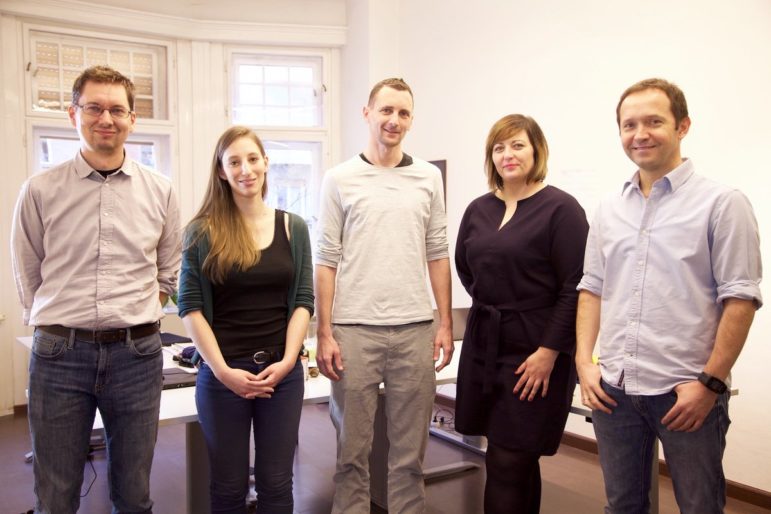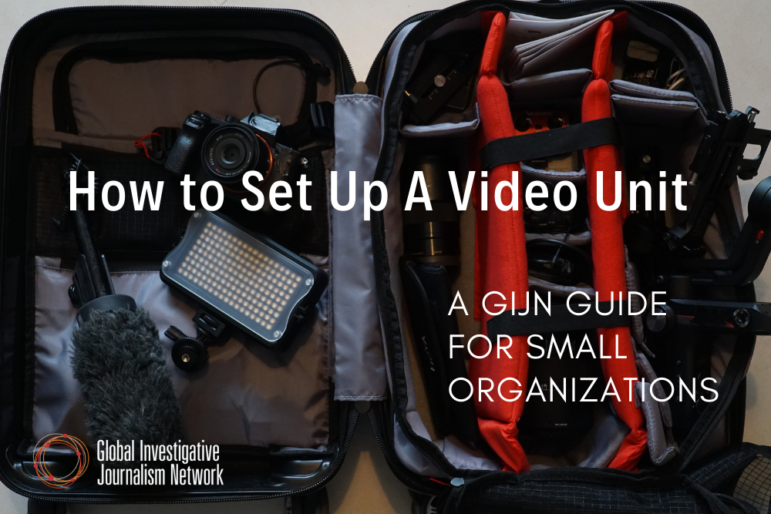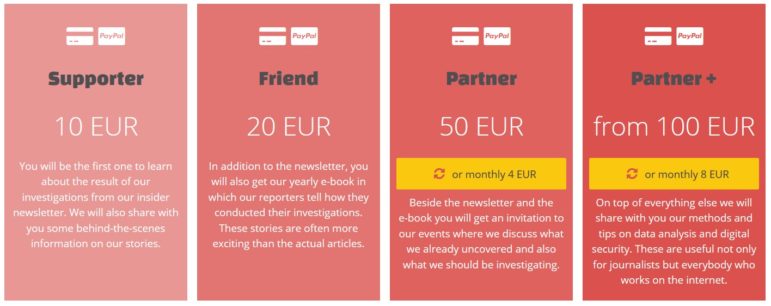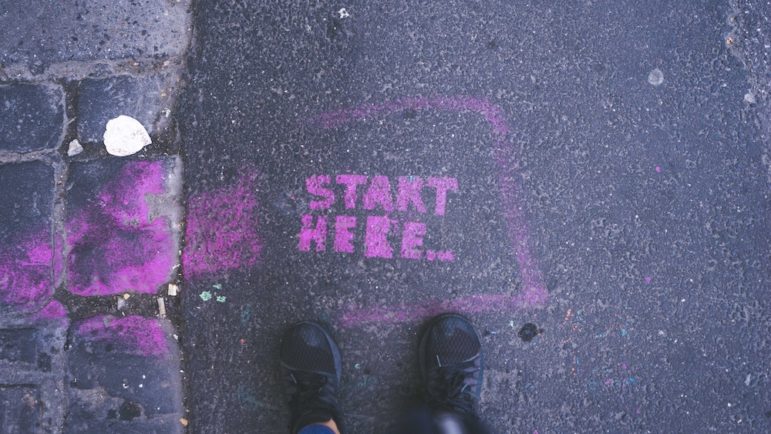

We Had Four Successful Crowdfunding Campaigns. Here Are 10 Tips for Your Newsroom
Read this article in

Paying Off: The team at Direkt36 has been raising money through crowdfunding. But it hasn’t been easy.
Before we launched Direkt36, a nonprofit investigative reporting center based in Budapest, three years ago, we had secured grants from international foundations. That funding would have been enough to last us for about a year, but we decided to kick off our site with a crowdfunding campaign. We knew that our organization would only be sustainable if it was be supported by the very same people who were following our work.
This decision paid off. Since the launch, more than 3,000 people have donated — a number of them after our names made the so-called “Soros mercenaries” list earlier this month. Last year, almost 50 percent of our expenses were covered by the revenue coming from crowdfunding.
Raising money this way takes continual effort, but every year we dedicate four weeks to an intensive campaign, seeking out new supporters and trying to convince the existing ones to renew their membership. Our latest campaign ended a few weeks ago and it has been our most successful membership drive so far. We raised nearly $50,000 in one month – not bad for a small country like Hungary, where supporting civic causes and philanthropy isn’t common practice.
Throughout our four campaigns we knew that crowdfunding was not an easy task. As the person in charge of planning and running these operations, I sometimes tell others that I owe some of my wrinkles to crowdfunding campaigns. To save you from some of that stress, I put together some of the most important lessons we have learned.
1. Talk to Someone Who’s Already Done It
One of the smartest things we did three years ago was reaching out to Sebastian Esser from the German magazine Krautreporter. He had just finished a massive campaign that raised $1.2 million. He generously spent a lot of time with us, walking through the necessary steps of a crowdfunding campaign. At times what we heard was quite discouraging, but we realized later on that he saved us from some embarrassing mistakes.
Because crowdfunding might seem easy — you post a fancy video about your obviously wonderful project to your many social media followers and how could they resist supporting it? — but it is not. Digital technology may have made it simple to reach people, but the internet is a noisy place and your idea will compete with many others for attention. So, if you want to succeed you will need a good plan and you need to execute it well.
2. Don’t be Afraid (or Ashamed) to Ask Advice from PR Professionals
Journalists often think they are great communicators. After all, our job is to tell stories and we write and/or speak all the time. Sorry to break the news, but these skills won’t help you much in a crowdfunding campaign. Telling a story with the aim of catching the audience’s attention is very different from persuading the audience to do something for you. Journalists might be good at the first point but the second one requires a totally different (and, for reporters, ethically dubious) approach. The relationship between journalists and PR people is inherently tense, but if there are a few you have not antagonized yet, reach out and ask for help. (Of course, make sure that this won’t cause any conflict of interest for you.)
I have longtime friends in the PR industry and they helped us craft our messages and plan our social media strategies. They made us realize simple things, such as the importance of explaining to the wider audience what investigative journalism is. They also told us that it’s not enough to ask for support, no matter how noble the cause. Your message needs to include how that support will make a difference and why that should matter to your supporters. As a result, in our own campaigns we don’t ask people to support investigative journalism. We ask them to invest in democracy.
3. Set a Goal and Justify It
Campaigning is fighting for something, and it doesn’t make sense to fight without a clear goal in mind. Simply saying “We need as much money as possible” is not enough. You need to figure out how much you want to raise, and you will have to make it clear why you need exactly that amount of money. This will give your campaign the necessary dynamics and sense of urgency.
Setting a goal might look simpler when you run a campaign for a specific story. Then you can put together an exact budget. People are said to be more willing to support a project that will result in a specific product (an article, a book, a video, etc.). In investigative journalism, however, this rarely works. Giving away your story idea at an early stage can put your investigation at risk. Also, it is not wise to make promises at the beginning of an investigative project. Reporting can lead to dead ends and the final product is often very different from what you imagined at the outset. So, in our own campaigns we have always raised money for our operational costs. In the most recent one, the goal was to raise at least 10 million forints (about US$40,000), and we explained that we needed at least this much so we could continue holding Hungary’s most powerful people to account.
4. Choose Your Platform Wisely
There is a wide range of crowdfunding platforms where you can run your campaign. Of course, there are the big ones like Indiegogo and Kickstarter, but there are others that specialize in journalism projects (like Steady, a new project by Sebastian Esser’s team, or Byline). These sites will provide you with a proper infrastructure for receiving payments and communicating with your supporters. But if you already have a well-known brand and website, you can also run your own campaign.
This is what we did at Direkt36 for our last three campaigns and it worked well. It requires some extra work from your developers to design a special site. Here’s how ours looks now; during the campaigns it also includes a video and a bar showing the amount we raised at a given point, but it also gives you more flexibility. You can include additional payment methods — we accept donations through normal bank transactions, checks or even bitcoin. If you have a multilingual site, you can run your campaign in different languages. And, of course, you also save the fee that you would otherwise have to pay for a professional crowdfunding platform.
5. Build Your Channels
After announcing the launch of Direkt36 in early 2015, it took about a week for us to gain 10,000 followers on Facebook. Quite naively, I thought that it would be easy to turn most of these people into supporters. Then I had a sobering chat with Sebastian from Krautreporter, who told me that only a few of those who “like” you on social media will actually support your project.
He suggested that we not only expand our social media audience, but more importantly, build a mailing list. He was right, email turned out to be a crucial tool in our campaigns, especially now that it is getting harder to reach people on Facebook, thanks to its ever-changing algorithm. Through newsletter applications (we use Mailchimp) you can fine-tune your messages to the different groups of people (for example, active members that you’d like to convince to renew their membership or passive members that you’d like to lure back). These two channels — social media and the newsletter — are crucial to our campaigns but, of course, you can also try to spread your message through traditional media. For example, if you have a new project, some news outlets might be interested in covering it.
6. Make a Good Video
To kick off your campaign you will need a video. It doesn’t have to look fancy but make sure that it’s short (one to two minutes) and to the point. (Here’s ours from the latest campaign. Sorry for the strong accent.) The video is important, but it won’t be enough.
Most campaigns run for at least four weeks, which is a long time to fill with meaningful content. So you need to prepare additional material: articles, videos, images. We look at our campaigns as an opportunity to tell more about who we are, what we do and why we do it. We publish stories about how we conducted our investigations, we do Facebook live broadcasts to answer questions from our followers, and we produce several explainer videos highlighting the impact of our work.
7. Create a Big Bang
For a crowdfunding campaign to be successful you will need to reach about 30 to 40 percent of your goal in the first few days. So, you will want to start with a big bang. In order to achieve this, make a list of people who could help you in spreading the word about the campaign. These are ideally people who are influential on social media (that’s why they are called “influencers”) or those who simply have a wide network of contacts and are willing to support a project like yours.
Reach out to these people well before your launch date, tell them why you need their help, and if they say yes, explain to them that when the campaign actually starts you would like them to share the news and convince their followers to support the project. This is something that you can ask not only from well-known influencers but also from your regular members. Tell them that even a social media post or an email to like-minded friends can be enormously helpful for your campaign.
8. Surviving the Valley of Death
If everything goes well, you will raise a substantial part of your funding goal in the first few days, but then the momentum will quickly slow. As Sebastian from Krautreporter put it, this is the “valley of death.” Money stops flowing, and your influencer friends move on to other stories. This will come inevitably, so be ready for it.
This is when you can use all that additional material (stories and videos about your work you prepared before the campaign). Most likely, you will need to spend some money to promote your posts on social media, but you can also explore alternative channels for spreading your message, including Facebook-groups, mailing lists, alumni communities and even live events.
What works really well is setting sub-goals in the middle of the campaign. Let’s say you are at a point where you need only $500 more to reach the $20,000 milestone. That’s when you can send out a message saying “Who’s going to help us reach this?” You can be pretty sure that the $500 will come in quite quickly.
In two weeks, we reached more than 75 percent of our #Crowdfunding goal. If you care about independent journalism, please help us get through the finish line #journalism #PressFreedom #Hungary https://t.co/O3La21t0Ui pic.twitter.com/k9PTeMruKH
— direkt36 (@direkt36) March 8, 2018
9. Save Energy for the Homestretch
If you survived the “valley of death” by raising at least 20 to 30 percent more toward your funding goal, then you have reasons for optimism. As you approach the final days of your campaign you can get back some of the previous momentum. This is the time to shout loud and clear that the campaign is almost over, and that you need help to achieve the goal. Many of your potential supporters will slap their foreheads and finally take their credit cards out of their wallet.
10. Don’t Just Ask, Give Something in Return
Here comes the most important part. If you want your supporters to stay with your organization for a long time, you need to build a community. It’s not enough to accept their money and to send them a thank you note. You want them to feel part of your project.
You can give them something tangible, like a t-shirt or a mug with your slogan and logo, but at Direkt36 we believe that getting insight into our work is worth much more for our supporters. They get exclusive newsletters about our upcoming stories, e-books about the backstories of our investigations, they are invited to our live events and we even share some of our work methods in workshops. This also acts as an incentive for the supporters to give higher donations (everybody gets the newsletter but only the most generous supporters get invited to the workshops). But what’s even more important is that, thanks to these interactions, now we know many of our supporters personally and we know that we can count on them to support our work and our next crowdfunding campaign.
 András Pethő is a co-founder and editor of Direkt36, a nonprofit investigative newsroom based in Budapest. Pethő spent much of his 16-year-long journalism career at Origo, once a leading online news site in Hungary. He also worked for the BBC World Service and was a visiting reporter at the investigative unit of The Washington Post.
András Pethő is a co-founder and editor of Direkt36, a nonprofit investigative newsroom based in Budapest. Pethő spent much of his 16-year-long journalism career at Origo, once a leading online news site in Hungary. He also worked for the BBC World Service and was a visiting reporter at the investigative unit of The Washington Post.










